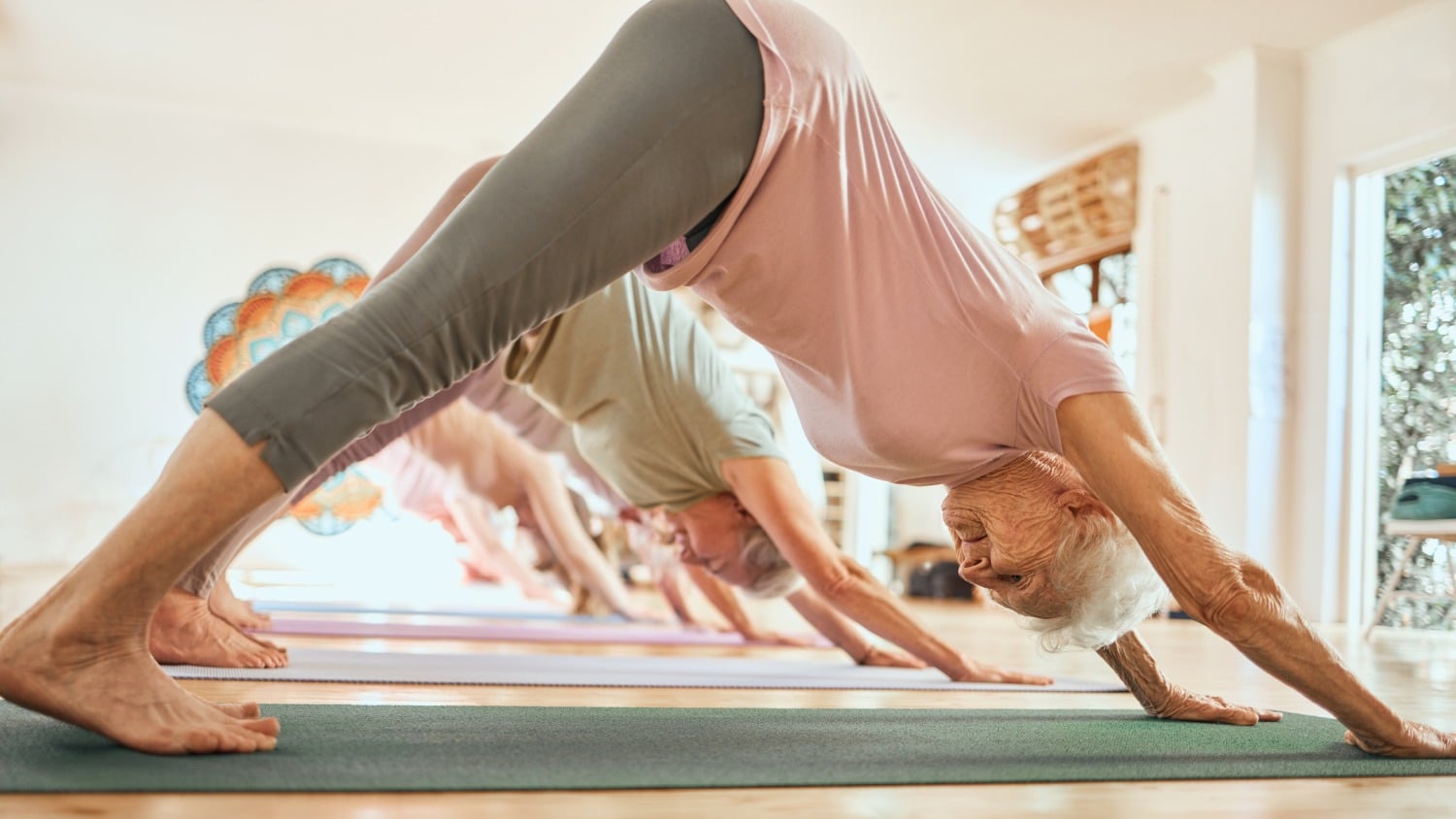After age 65, many people begin to notice that everyday activities come with new challenges. Joint pain—especially in the knees, hips, shoulders, and spine—becomes a common complaint. According to the U.S. Centers for Disease Control and Prevention, nearly 50% of adults over 65 report some form of arthritis-related joint pain. For many, this discomfort reduces mobility, impacts independence, and even leads to feelings of frustration or depression.
Doctors often suggest swimming or Pilates as safe, joint-friendly exercises. While both are effective, they can feel intimidating, expensive, or less accessible for some seniors. Yet, there exists another practice that is simple, gentle, widely accessible, and surprisingly powerful in reducing joint pain: yoga.
Yoga is more than a workout—it is a holistic system that combines mindful breathing, gentle stretching, and strengthening postures. For seniors, it can be a life-changing approach to managing pain, improving mobility, and fostering emotional resilience. This article explores why yoga is particularly suited for older adults, the science-backed benefits it offers, and how seniors can safely integrate it into their daily lives.
Why Yoga is Perfect for Seniors with Joint Pain
Unlike high-impact workouts or physically demanding sports, yoga adapts to the individual. It does not require extreme flexibility or athletic ability. Instead, it emphasizes mindful movement, body awareness, and breath control—all of which align with the needs of older adults managing joint issues.
Key reasons yoga suits seniors:
- Gentle on joints: Movements are slow, controlled, and adjustable.
- Accessible: Yoga can be practiced sitting in a chair, using props, or even lying down.
- Adaptable: There are modifications for nearly every pose, making it suitable for those with limited mobility or chronic pain.
- Holistic: Yoga nurtures not just the body, but also mental and emotional well-being.
Stats on Joint Pain and Aging
| Health Concern Among Seniors (65+) | Prevalence in the U.S. Population | Impact on Daily Life |
|---|---|---|
| Arthritis and Joint Pain | ~49% of adults 65+ | Limits walking, standing, daily chores |
| Falls and Balance Issues | 1 in 4 seniors fall each year | Leading cause of injury in older adults |
| Sleep Problems | ~50% report poor sleep | Increases fatigue and pain sensitivity |
| Medication Dependence | 75% take prescription meds daily | Risk of side effects and reduced independence |
Yoga directly addresses many of these issues, making it an excellent complementary approach to senior wellness.
Benefits of Yoga Beyond Flexibility
Most people associate yoga with stretching, but for seniors, the benefits go much deeper.
Improves Balance and Prevents Falls
Falls are a serious concern in older age, leading to fractures and hospitalization. Yoga strengthens stabilizing muscles, improves coordination, and trains proprioception (the body’s awareness of movement and position). Even basic standing poses like Mountain Pose or Tree Pose improve balance when practiced regularly.
Supports Better Sleep
Gentle yoga has been shown to calm the nervous system, reduce stress hormones, and encourage deeper, more restorative sleep. This is especially important for seniors, since poor sleep worsens pain and contributes to cognitive decline.
Reduces Medication Dependence
Chronic pain often leads to heavy reliance on painkillers or anti-inflammatory medications. Over time, these can cause side effects, from digestive issues to kidney strain. Yoga provides a natural, non-invasive way to manage pain and stiffness, often reducing the need for medication.
Enhances Mental Well-Being
Aging can bring emotional challenges such as loneliness, stress, or fear of losing independence. Yoga emphasizes mindfulness and deep breathing, which lower stress, boost mood, and foster a sense of control over the body.
How Yoga Helps Strengthen Joints
Joints rely on the muscles around them for stability and support. Weak muscles increase strain on cartilage and bones, worsening pain and stiffness. Yoga strengthens these supportive muscles gently, without overloading sensitive areas.
Physiological Effects of Yoga on Joints:
- Strengthens surrounding muscles – Poses like Warrior II or Bridge build leg and hip strength.
- Promotes circulation – Stretching and deep breathing enhance blood flow, delivering nutrients to joint tissues.
- Reduces inflammation – Yoga lowers stress hormones like cortisol, which are linked to inflammation.
- Encourages weight management – Gentle activity helps maintain a healthy weight, reducing pressure on weight-bearing joints like knees and hips.
Practical Yoga Poses for Joint Relief
Seated Forward Bend (Paschimottanasana – Chair Variation)
Sit tall on a chair, extend legs forward, and lean gently toward your thighs while keeping the spine long. This stretches the hamstrings and back without strain.
Chair Twist
Sitting with feet flat, gently twist your torso to one side, holding onto the chair for support. Repeat on the other side. This reduces spinal stiffness and improves posture.
Modified Downward Dog (Using a Chair)
Stand facing a chair, place your hands on the seat, step back, and stretch your hips backward, keeping the spine long. This pose strengthens arms and legs while gently stretching the back.
Yoga vs. Other Recommended Exercises for Seniors
| Exercise Type | Pros for Seniors | Cons for Seniors |
|---|---|---|
| Swimming | Non-weight bearing, excellent cardio | Requires access to a pool, may not build bone density |
| Pilates | Strengthens core, improves posture | Can be equipment-heavy, more complex movements |
| Walking | Easy, low-cost, improves cardiovascular health | May strain joints if overdone, less focus on flexibility |
| Yoga | Gentle, adaptable, strengthens and stretches | Requires guidance at first, risk if poses are forced |
Science-Backed Evidence Supporting Yoga for Seniors
- Studies show that older adults practicing yoga 2–3 times per week experience 25–30% improvement in flexibility and mobility within 8–12 weeks.
- Yoga practitioners report a 40% reduction in pain intensity in arthritis-related joint discomfort.
- Fall risk decreases significantly, with some trials showing up to 50% fewer falls among seniors practicing balance-focused yoga.
Emotional and Social Benefits
Beyond the physical, yoga nurtures the human spirit. Many seniors find that yoga classes become a social outlet, reducing feelings of isolation. Breathing exercises and meditation also improve emotional resilience, giving older adults tools to manage stress, grief, or anxiety.
Safe Yoga Practice for Seniors
While yoga is safe for most, certain precautions ensure a positive experience:
- Consult a doctor if you have recent injuries, sciatica, or joint replacements.
- Use props like chairs, cushions, or yoga blocks to provide extra support.
- Start slow with beginner or senior-specific classes.
- Listen to your body—never push through pain.
- Practice consistency—short daily sessions (10–15 minutes) are more effective than occasional long ones.
Real-Life Impact: Stories of Transformation
Many seniors report dramatic improvements after adopting yoga. For example:
- A 70-year-old woman with chronic knee pain reduced her medication after 3 months of chair yoga.
- A retired teacher regained confidence in walking outdoors after practicing balance poses for 6 weeks.
- Couples practicing yoga together reported not only less pain but also stronger emotional connection.
The Bigger Picture: Yoga as a Tool for Healthy Aging
Healthy aging is about more than just living longer—it’s about living well. Yoga contributes to:
- Mobility – reducing stiffness and encouraging independence.
- Strength – preserving muscle mass, which naturally declines with age.
- Emotional peace – fostering acceptance, resilience, and mindfulness.
- Community – offering shared experiences and support.
Conclusion
Joint pain doesn’t have to define the aging experience. While many seniors turn to swimming or Pilates, yoga presents a simpler, gentler, and equally powerful path to relief and vitality. By improving flexibility, balance, strength, sleep, and emotional well-being, yoga supports the body and mind in harmony.
For seniors seeking independence, mobility, and comfort in their golden years, yoga may be the key to aging with grace, confidence, and less pain.
So, unroll that mat—or simply pull up a chair—and explore the transformative world of yoga. Your joints, mind, and spirit will thank you.






Leave a Comment